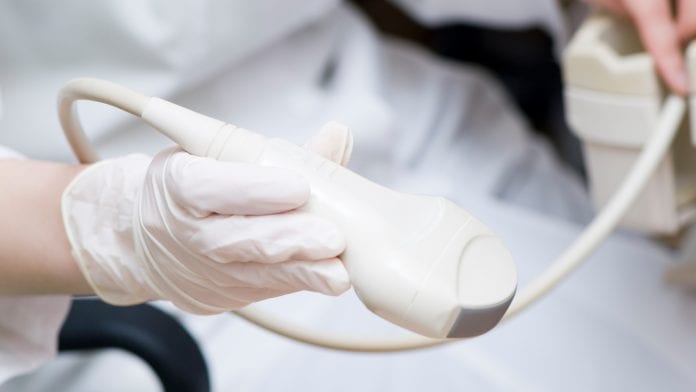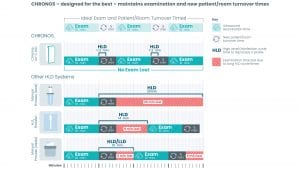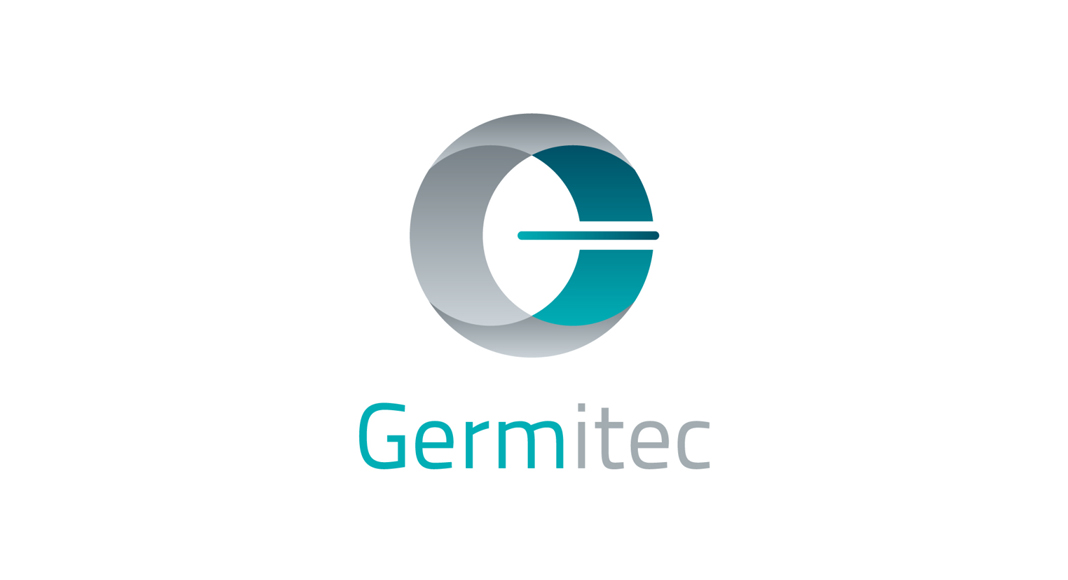
Germitec’s Hypernova Chronos UVC system is ‘light years ahead’ as the only chemical-free solution for ultrasound probe disinfection.
Backed by more than 15 years of design and development within sustainable hospital hygiene solutions, Germitec’s Hypernova Chronos has radically simplified the lives of healthcare professionals in terms of safety, time, and responsibility. Its breakthrough patent UVC technology replaces chemistry with photons, providing a more environmentally friendly method to the traditional chemical wipes, chemical soak stations and chemical hydrogen peroxide mist which have previously been used in ultrasound probe disinfection.
Germitec meets ISO 13485 highest standards in achieving a comprehensive quality management system for the design and manufacture of innovative medical devices. It has been recognised as an innovative company by the French Public Investment Bank (BPI) and has been awarded the Seal of Excellence European Union Funding for Research & Innovation. Germitec received the 2020 Prix Galien Award for Best Medical Device for its Hypernova Chronos™ system. The award recognises excellence in scientific innovation that improves the human condition globally. The Prix Galien award is considered equivalent to the Nobel Prize in biopharmaceutical and medical technology research.
Hypernova Chronos is approved in more than 35 countries worldwide and is now spanning regions in Asia, Middle East, Europe, and the Americas.
How UVC high-level disinfection technology works
The technology works by delivering UVC high-level disinfection (HLD) as light particles and waves reflected from the chamber walls ensure that there is proper illumination and efficient exposure on the ultrasound probe’s surfaces. The UVC HLD energy of the photons penetrates the cell walls of microorganisms (bacteria, fungi, viruses, mycobacteria and spores), which is absorbed by DNA, RNA and the proteins, leaving them unable to perform cellular functions and replication, therefore destroying them.
Why Hypernova Chronos?
Ultrasound has become a cornerstone in the diagnosis and treatment of patients in various fields of medicine: women’s health, radiology and imaging, urology, outpatient/day surgery, intensive care, and accident and emergency. To achieve the full ultrasound benefits in patient care, medical teams need to consider the clinical workflow speed and contamination risk over repeated use of probes as a vector for pathogen transmission. To make this possible, medical teams are choosing Hypernova Chronos.
Hypernova Chronos delivers a fast, simple and clean UVC solution to reduce the risk of cross-infection, achieving seamless ultrasound probe high-level disinfection.
Reducing time and costs
The Chronos 90-second HLD cycle time streamlines clinical workflows, drastically reducing time and costs. For clinical workflows that require a 10-minute patient examination time, with a five-minute turnaround time (such as women’s health, fertility medicine, IVF, emergency, intensive care and others), Chronos is extremely efficient at quickly disinfecting ultrasound probes between patients to help maximise the number of appointments. Other HLD systems can take significantly longer, directly impacting the number of examinations that can be achieved per day1.
For example, manual chemical soaking processes increase patient turnaround times by up to 32 minutes, automated hydrogen peroxide systems can add up to 14 minutes, while a wipe system adds about 10 minutes.
To maintain a five-minute turnaround time, purchasing extra probes and hiring dedicated staff to clean and disinfect probes may be required. This adds additional costs on top of the cost of chemicals and other consumables such as chemical indicators or test strips.

Fully automated and simpler
The Chronos ultrasound probe disinfection system is fully automated and has a simple one-button process to activate HLD and traceability. Furthermore, Chronos offers:
- A simple ‘plug-and-play’ design that minimises staff interaction and training requirements;
- An easy probe loading and unloading mechanism;
- Single cycle disinfection of the probe and the cable section;
- A mobile device within departments; and
- Point-of care-ultrasound, to support quick diagnosis and assessment.
Chronos’s traceability system electronically captures and stores data during the disinfection cycle. Data can be easily accessed through Germitrac, an interface that visually displays all disinfection records through a web browser (via a computer or hospital network linked to the Chronos by an ethernet cable).
Integrated with the hospital network, the digital disinfection records can be manually linked to a patient profile and automated through a third-party software, accessing Germitrac application programming interface (API) web services to retrieve disinfection data and link it to a patient’s digital record.
Cleaner
Chronos is revolutionising high-level disinfection as the only chemical free system. Chronos is also the only automated system proven to kill native human papillomavirus (HPV) both in vitro and in clinical use.
- UVC HLD energy is non-corrosive and safe for your probes which is why many leading ultrasound probe manufacturers have approved the use of Chronos in probe disinfection, supported by extensive compatibility testing;
- There are no probe cable clamps that cause wear and tear on probe cables;
- The chemical free operation safeguards staff and patients by avoiding hazardous chemicals, fumes, and spills;
- No chemical residuals are left on the probe after disinfection, eliminating the risk of contaminating the probe when wiping off residual chemicals post HLD or exposing the operator and patient to chemical burns on the hand or face or impacting oocyte retrieval, embryo transfer and other IVF applications during pelvis ultrasound probe procedures2-4; and
- Provides an environmentally friendly examination room that is ideal for point of care ultrasound.
It has been independently tested and complies with testing requirements set by different regulators. The company works with leading laboratories and scientific centres in France, the United Kingdom, Germany and the United States.
Contamination risk following low-level disinfection
Some institutions and medical teams use low-level disinfection (LLD) and may not be fully aware of the contamination risks after use on an ultrasound probe that is classified as semi-critical. Under the Spaulding classification the ultrasound probe is classified into non-critical probe, semi-critical probe or critical probe, determined by how the probe comes in contact with the patient’s procedure site and the level of cross-infection risk. A semi-critical probe must be high level disinfected (HLD) as the probe may have been in contact with non-intact skin (wound or burn) or mucus membranes and the potential risk of cross-infection is considered medium to high. HLD kills all viable microorganisms, except a small number of bacterial spores. However, LLD kills vegetative bacteria, except mycobacteria, fungi and non-enveloped viruses, therefore HLD is necessary5.
There are several studies that show low-level disinfection wipes are not as effective as high-level disinfection methods5-11. A recent study in a clinical setting confirmed that the LLD procedure alone is unsafe compared to using a HLD method such as UVC, which can reliably inactivate pathogens including HPV. The study stated that the automated HLD method is strongly recommended to ensure patient safety12-13.
In a 2010 to 2016 study looking at the risk of infection following semi-invasive ultrasound procedures in Scotland, LLD was shown to be insufficient. This was demonstrated by the results of a retrospective, cohort study using linked national datasets from Scotland. The study revealed an increased infection risk in the 30 days following endocavity ultrasound13.
Various global guidelines recommend high-level disinfection, preferred over LLD for probes classified as semi-critical and critical probes5-11.
A meta-analysis found that in procedures using LLD wipes, contamination remained up to 12.9% for pathogenic bacteria and 1% for pathogenic viruses on endocavity probes. Stating the probability of infection, transmission of viral pathogens to patients from these procedures was estimated to be 1% to 6%15.
High risk of infection following low-level disinfection
In a study conducted at the gynaecology department of the Lyon University Hospital from July to October, 216 samples were collected before the ultrasound examination, after a low-level disinfection was applied. The results showed:
- 5% transvaginal probes detected to be contaminated with HR-HPV post examination; and
- 8% transvaginal probes detected to be contaminated with HR-HPV pre-examination.
The study concluded that in all hospitals, where LLD is performed, the endovaginal ultrasound procedure must be considered a source for nosocomial, high risk HPV infections, recommending stringent use of high-level disinfectants16.
Therefore, a high-level disinfection system proven to kill high-risk, cancer-causing HPV is recommended. Research reveals that virtually all cervical cancers (more than 90%) are caused by high-risk Human Papillomaviruses (HPV16 and HPV18)17.
HPV is a highly resistant virus, more so than other non-enveloped viruses previously tested. Published test results showed that commonly used clinical disinfectants, including those used as sterilants in medical and dental healthcare facilities, have no effect on HPV16 and HPV18.
Results suggest that healthcare facilities using endocavity ultrasound probes need to strongly consider disinfection methods that are effective against native HPV, adopting new technologies, such as Hypernova Chronos UVC HLD, which have been rigorously tested to kill Human Papillomavirus, high-risk cancer strains 16 and 1813,18.
What our customers are saying
Dr Ippokratis Sarris, director of King’s Fertility, said: “We selected Hypernova Chronos based on its innovative technology, and because the system is chemical-free. It is also easy to use and has a short disinfection cycle, making it ideal for a busy fertility centre like ours. In addition, it is rigorously tested against high-risk cancer strains of Human Papillomavirus that provides extra safety for our patients.”
Dr Genevieve Carbonatto, emergency physician and educator in ultrasound courses and workshops at Royal Prince Alfred Hospital, commented: “I used a hydrogen peroxide device then moved to Chronos. An ideal solution as we have 280 presentations per day. For us, it was a game-changing device. You don’t know what viruses or bacteria the patient has on their skin, as we have all types of patients that come into our Emergency department.”
Dr Clabeau, gynaecologist at the European Hospital Georges Pompidou, said: “Speed, simplicity, efficacy, it means everything. Thanks to this process I multiplied the number of vaginal ultrasounds performed daily by five. I am extremely satisfied by the system. I have waited a long time for a solution of this kind, I could not work without it.”
Pierre Leger, Head of Biomedical department and Edith Gumbeau, nurse, Foundation St. Joseph, Marseille, added: “It is safer for patients because we do not use corrosive chemicals anymore. It is a less corrosive HLD technique. Before UV HLD, our probe’s shelf life was very short. Last year for example we had to buy four or five vaginal ultrasound probes. Since UV, we practically use one probe.”
A Lead Fertility Nurse at Imperial College said: “With the significant number of transvaginal scans being performed in a fertility clinic, probe disinfection is a top priority. We needed a cost effective level 3 system that is quick and easy to do. It was a joy to be given the opportunity to use the Germitec UVC probe disinfection system as it provided the level of disinfection required and simplified the method of cleaning the probe from the three-step procedure we were doing after each scan. It is also noteworthy that no chemicals were involved, no consumables and is environmentally friendly since it has zero percent packaging.”
References
1 Johnson et al. Evaluation of a hydrogen peroxide-based system for high-level disinfection of vaginal ultrasound probes. Journal of Ultrasound Medicine 32:1799-804, 2013.
2 Rutala WA, Weber DJ, HICPAC. 2008. Guideline for Disinfection and Sterilisation in Healthcare Facilities. In Control CfD (ed.), USA.
3 Sagripanti JL, Bonifacino A. 2000. Cytotoxicity of liquid disinfectants. Surgical infections 1:3-14.
4 Ackerman SB et al. Toxicity testing for human in vitro fertilisation programs. J In Vitro Fert Embryo Transf, 1985. 2(3): p. 132-7.
5 Westerway SC et al. Endocavity ultrasound transducers: why high-level disinfection is necessary. Ultraschall Med. DOI: 10.1055/a-1168-6602, 2020
6 Nyhsen CM et al. (2017). Infection prevention and control in ultrasound – best practice recommendations from the European Society of Radiology Ultrasound Working Group. Insights Imaging 8 (6): 523-535.
7 French Ministry of Health issues guidance requiring disinfection of endocavitary ultrasound probes: https://solidarites-sante.gouv.fr/soins-et-maladies/qualite-des-soins-et-pratiques/securite/article/prevention-des-risques-d-infection-associes-a-l-utilisation-des-sondes-d.
8 Health Service Executive (HSE) Quality Improvement Division (2017). HSE guidance for decontamination of semi-critical ultrasound probes: semi-invasive and non-invasive ultrasound probes. Document: QPSD-GL-028-1.
9 Health Facilities Scotland, NHS National Services Scotland, Health Protection Scotland, March 2016. NHS Scotland guidance for decontamination of semi-critical ultrasound probes: semi-invasive and non-invasive ultrasound probes. Document: HPS/HFS Version 1.0.
10 Kollmann C, Salvesen K. (2017). Best practice recommendations for cleaning and disinfection of ultrasound transducers whilst maintaining transducer integrity. European Committee for Medical Ultrasound Safety (ECMUS).
11 Jacques S et al. (2017). Guidelines for cleaning transvaginal ultrasound transducers between patients. World Federation for Ultrasound in Medicine and Biology.
12 Bloc S et al. (2011). Evaluation of a new disinfection method for ultrasound probes used for regional anesthesia: ultraviolet C light. J Ultrasound Med. 2011 Jun;30(6):785-8. www.ncbi.nlm.nih.gov/pubmed/21632992
13 Pichon M et al. (2019). Decontamination of intravaginal probes infected by Human Papillomavirus (HPV) using UVC decontamination systems. J Clin Med, 8, 1776; doi:10.3390/jcm8111776.
14 Scott D et al. Risk of infection following semi-invasive ultrasound procedures in Scotland, 2010 to 2016: A retrospective cohort study using linked national datasets. Ultrasound 2018 Aug;26(3):168-177. doi: 10.1177/1742271X18774594.
15 Leroy S et al. (2014). Impact of vaginal-rectal ultrasound examinations with covered and low-level disinfected transducers on infectious transmissions in France. Infect Control Hosp Epidemiol 35(12): 1497-1504.
16 Casalegno et al. (2012). High Risk HPV Contamination of Endocavity Vaginal Ultrasound Probes: An Underestimated Route of Nosocomial Infection? PLOS ONE.
17 Meyers J et al. Susceptibility of high-risk human papillomavirus type 16 to clinical disinfectants. J Antimicrob Chemother. 2014;69(6):1546-50.
18 Meyers C, Milici J, Robison R. (2017). UVC radiation as an effective disinfectant method to inactivate human papillomaviruses. PLOS ONE 12 (10): e0187377
This article is from issue 17 of Health Europa. Click here to get your free subscription today.

























